Techniques of Predictive Analysis
VerifiedAdded on 2023/03/31
|9
|1784
|449
AI Summary
This article discusses the techniques used in predictive analysis, including data mining, data modelling, machine learning, statistics, and artificial intelligence. It explains how businesses and the healthcare industry use predictive analysis to plan for the future and make informed decisions. The article also explores the application of predictive analytics in customer relationship management, healthcare, cross sell, fraud detection, risk management, direct marketing, and underwriting.
Contribute Materials
Your contribution can guide someone’s learning journey. Share your
documents today.
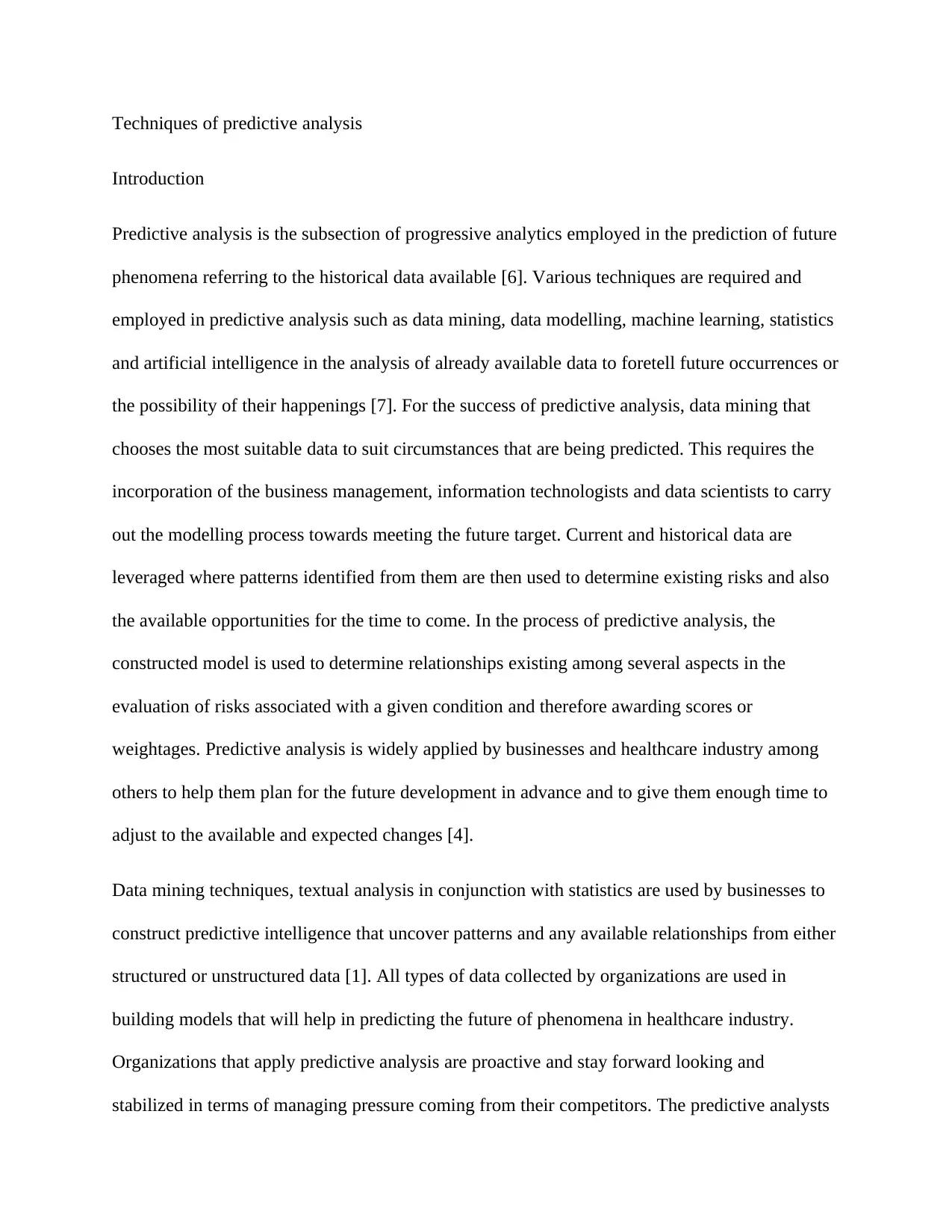
Techniques of predictive analysis
Introduction
Predictive analysis is the subsection of progressive analytics employed in the prediction of future
phenomena referring to the historical data available [6]. Various techniques are required and
employed in predictive analysis such as data mining, data modelling, machine learning, statistics
and artificial intelligence in the analysis of already available data to foretell future occurrences or
the possibility of their happenings [7]. For the success of predictive analysis, data mining that
chooses the most suitable data to suit circumstances that are being predicted. This requires the
incorporation of the business management, information technologists and data scientists to carry
out the modelling process towards meeting the future target. Current and historical data are
leveraged where patterns identified from them are then used to determine existing risks and also
the available opportunities for the time to come. In the process of predictive analysis, the
constructed model is used to determine relationships existing among several aspects in the
evaluation of risks associated with a given condition and therefore awarding scores or
weightages. Predictive analysis is widely applied by businesses and healthcare industry among
others to help them plan for the future development in advance and to give them enough time to
adjust to the available and expected changes [4].
Data mining techniques, textual analysis in conjunction with statistics are used by businesses to
construct predictive intelligence that uncover patterns and any available relationships from either
structured or unstructured data [1]. All types of data collected by organizations are used in
building models that will help in predicting the future of phenomena in healthcare industry.
Organizations that apply predictive analysis are proactive and stay forward looking and
stabilized in terms of managing pressure coming from their competitors. The predictive analysts
Introduction
Predictive analysis is the subsection of progressive analytics employed in the prediction of future
phenomena referring to the historical data available [6]. Various techniques are required and
employed in predictive analysis such as data mining, data modelling, machine learning, statistics
and artificial intelligence in the analysis of already available data to foretell future occurrences or
the possibility of their happenings [7]. For the success of predictive analysis, data mining that
chooses the most suitable data to suit circumstances that are being predicted. This requires the
incorporation of the business management, information technologists and data scientists to carry
out the modelling process towards meeting the future target. Current and historical data are
leveraged where patterns identified from them are then used to determine existing risks and also
the available opportunities for the time to come. In the process of predictive analysis, the
constructed model is used to determine relationships existing among several aspects in the
evaluation of risks associated with a given condition and therefore awarding scores or
weightages. Predictive analysis is widely applied by businesses and healthcare industry among
others to help them plan for the future development in advance and to give them enough time to
adjust to the available and expected changes [4].
Data mining techniques, textual analysis in conjunction with statistics are used by businesses to
construct predictive intelligence that uncover patterns and any available relationships from either
structured or unstructured data [1]. All types of data collected by organizations are used in
building models that will help in predicting the future of phenomena in healthcare industry.
Organizations that apply predictive analysis are proactive and stay forward looking and
stabilized in terms of managing pressure coming from their competitors. The predictive analysts
Secure Best Marks with AI Grader
Need help grading? Try our AI Grader for instant feedback on your assignments.
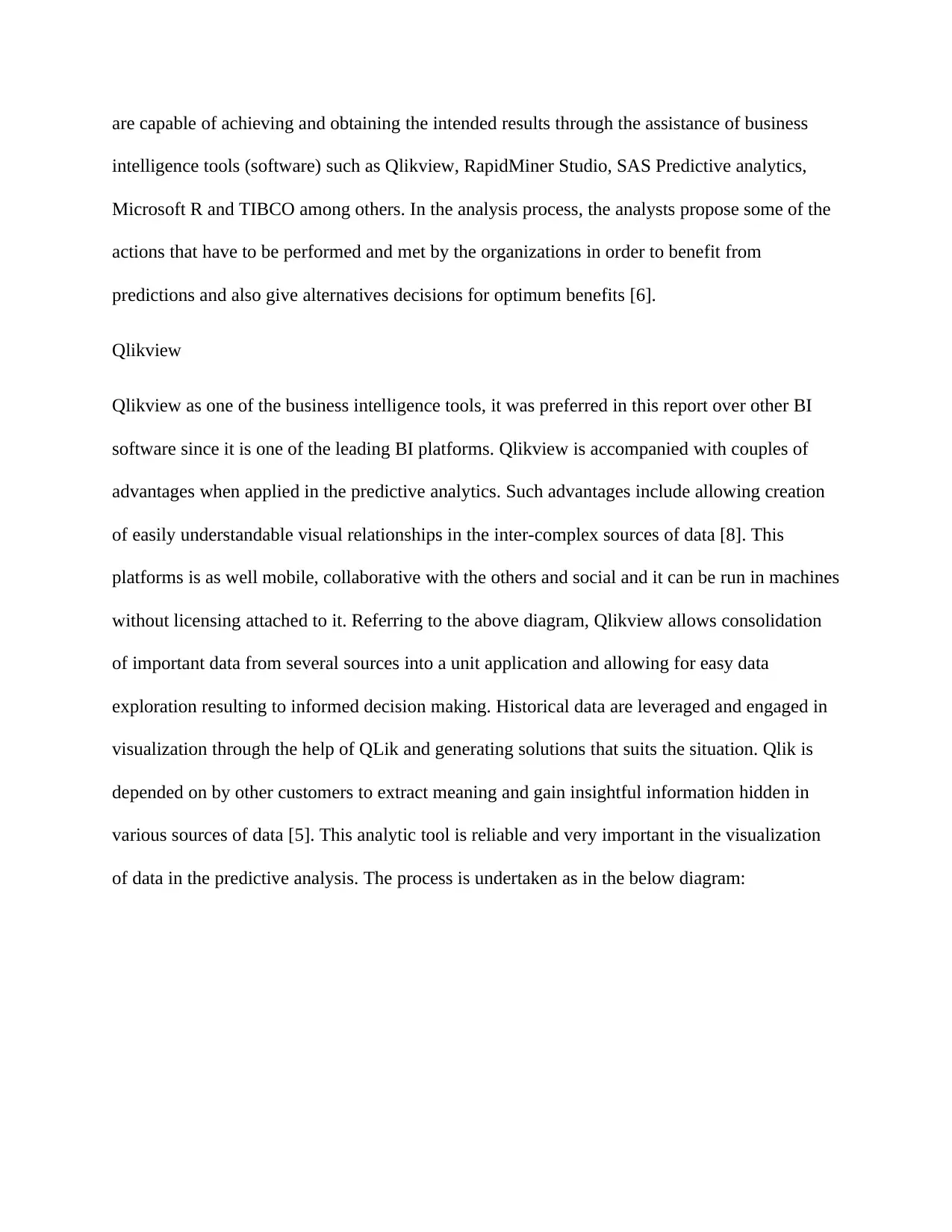
are capable of achieving and obtaining the intended results through the assistance of business
intelligence tools (software) such as Qlikview, RapidMiner Studio, SAS Predictive analytics,
Microsoft R and TIBCO among others. In the analysis process, the analysts propose some of the
actions that have to be performed and met by the organizations in order to benefit from
predictions and also give alternatives decisions for optimum benefits [6].
Qlikview
Qlikview as one of the business intelligence tools, it was preferred in this report over other BI
software since it is one of the leading BI platforms. Qlikview is accompanied with couples of
advantages when applied in the predictive analytics. Such advantages include allowing creation
of easily understandable visual relationships in the inter-complex sources of data [8]. This
platforms is as well mobile, collaborative with the others and social and it can be run in machines
without licensing attached to it. Referring to the above diagram, Qlikview allows consolidation
of important data from several sources into a unit application and allowing for easy data
exploration resulting to informed decision making. Historical data are leveraged and engaged in
visualization through the help of QLik and generating solutions that suits the situation. Qlik is
depended on by other customers to extract meaning and gain insightful information hidden in
various sources of data [5]. This analytic tool is reliable and very important in the visualization
of data in the predictive analysis. The process is undertaken as in the below diagram:
intelligence tools (software) such as Qlikview, RapidMiner Studio, SAS Predictive analytics,
Microsoft R and TIBCO among others. In the analysis process, the analysts propose some of the
actions that have to be performed and met by the organizations in order to benefit from
predictions and also give alternatives decisions for optimum benefits [6].
Qlikview
Qlikview as one of the business intelligence tools, it was preferred in this report over other BI
software since it is one of the leading BI platforms. Qlikview is accompanied with couples of
advantages when applied in the predictive analytics. Such advantages include allowing creation
of easily understandable visual relationships in the inter-complex sources of data [8]. This
platforms is as well mobile, collaborative with the others and social and it can be run in machines
without licensing attached to it. Referring to the above diagram, Qlikview allows consolidation
of important data from several sources into a unit application and allowing for easy data
exploration resulting to informed decision making. Historical data are leveraged and engaged in
visualization through the help of QLik and generating solutions that suits the situation. Qlik is
depended on by other customers to extract meaning and gain insightful information hidden in
various sources of data [5]. This analytic tool is reliable and very important in the visualization
of data in the predictive analysis. The process is undertaken as in the below diagram:

1) Diagram for predictive analytics process
Process of predictive analysis
First and foremost, the analysts need to define the project. In the definition of the project,
expected results, objectives to be met, sources of data sets to be used in the project all need to be
brought forth and put into consideration [10]. Consequently, follows the data collection process
which include mining of data that best suit the predictive analysis from all the earlier identified
sources for analysis. In the analysis process, data is undertaken into series of inspections,
transformation, cleaning and modelling with the aim of determining useful information leading
to drawing conclusion. Standard statistical models are applied in the test of assumptions,
hypothesis and thus validation. Since the aim is to create to carryout predictive analysis,
predictive models are developed with the ability to accurately predict the future with minimum
or no errors involved if all factors kept constant. Qlikview is engaged in the process of predictive
data analysis to ensure that different sources are successfully accessed and relevant data drawn.
Data modelling also allows choices of coming up with many models for the best solution.
Process of predictive analysis
First and foremost, the analysts need to define the project. In the definition of the project,
expected results, objectives to be met, sources of data sets to be used in the project all need to be
brought forth and put into consideration [10]. Consequently, follows the data collection process
which include mining of data that best suit the predictive analysis from all the earlier identified
sources for analysis. In the analysis process, data is undertaken into series of inspections,
transformation, cleaning and modelling with the aim of determining useful information leading
to drawing conclusion. Standard statistical models are applied in the test of assumptions,
hypothesis and thus validation. Since the aim is to create to carryout predictive analysis,
predictive models are developed with the ability to accurately predict the future with minimum
or no errors involved if all factors kept constant. Qlikview is engaged in the process of predictive
data analysis to ensure that different sources are successfully accessed and relevant data drawn.
Data modelling also allows choices of coming up with many models for the best solution.
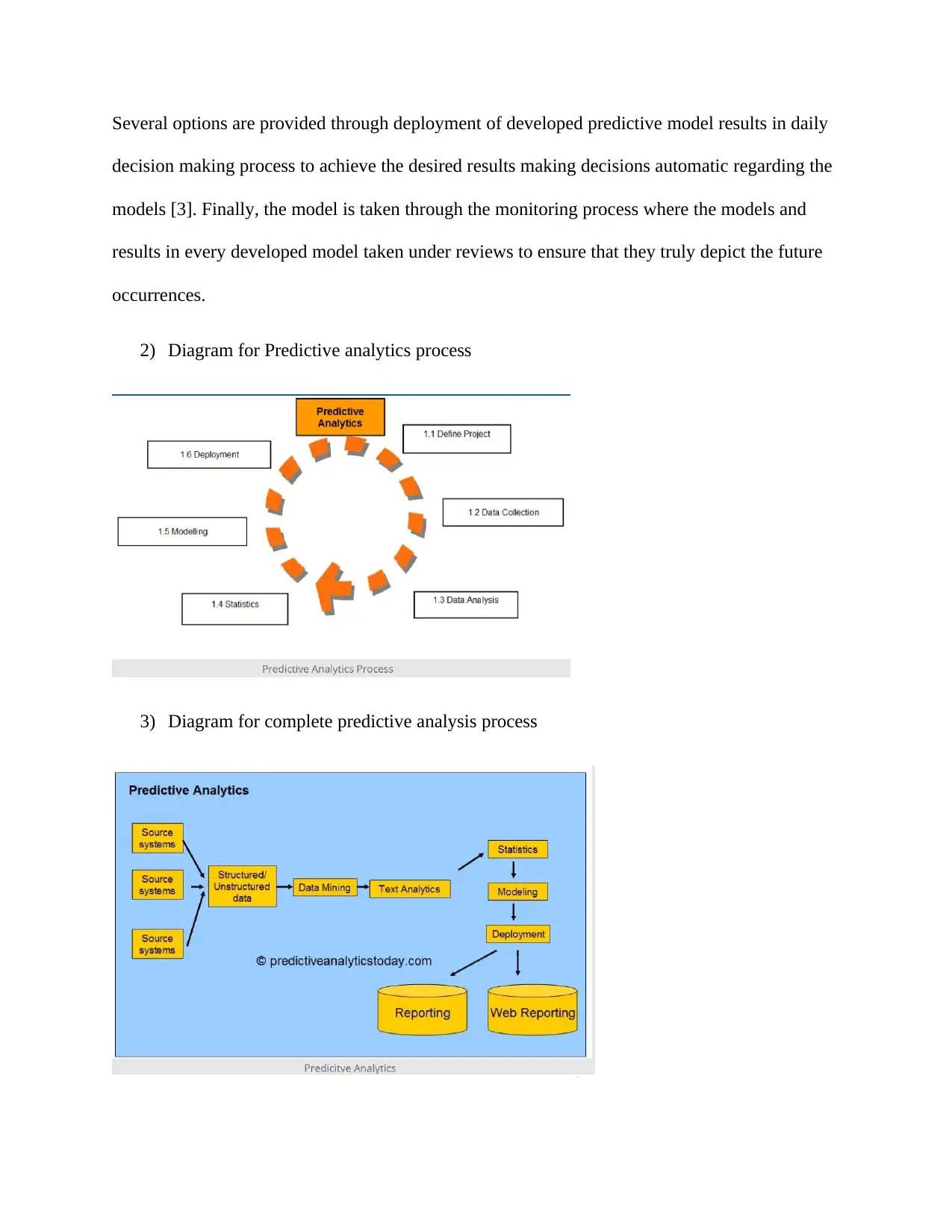
Several options are provided through deployment of developed predictive model results in daily
decision making process to achieve the desired results making decisions automatic regarding the
models [3]. Finally, the model is taken through the monitoring process where the models and
results in every developed model taken under reviews to ensure that they truly depict the future
occurrences.
2) Diagram for Predictive analytics process
3) Diagram for complete predictive analysis process
decision making process to achieve the desired results making decisions automatic regarding the
models [3]. Finally, the model is taken through the monitoring process where the models and
results in every developed model taken under reviews to ensure that they truly depict the future
occurrences.
2) Diagram for Predictive analytics process
3) Diagram for complete predictive analysis process
Secure Best Marks with AI Grader
Need help grading? Try our AI Grader for instant feedback on your assignments.

Application of predictive analytics techniques
Predictive analytics is employed in the variety of fields to ensure that they are propelled towards
achieving their objectives and conforms to the predicted changes. Some of the areas where
predictive analytics is applied include; in customer relationship manager (CRM), in the
healthcare industry, cross sell, fraud detection, risk management, direct marketing and
underwriting.
Customer relationship manager (CRM)
Aims of businesses are always directed towards making profits and they do anything possible to
ensure that they achieve this objective. In that regards therefore, businesses apply techniques of
predictive analytics in making sure that the customer relationship with the business is well
defined and managed by the organization [9]. The insights through the data analysis techniques
offers variety of suggestions across fields of the business organization such as marketing, sales
and the customer services. This will help the business to stay put with the market features which
can then be used in the entire life cycle of the customers. Best knowledge about the market by
business organization helps in steering growth of relationship with customers and their retention.
Heath care
Just like in business, health care industry also need to employ the techniques of data analytics.
Health care industry need to prepare itself to curb any changes that might be arising in the
process and this is achieved by analyzing the healthcare data currently available and using the
results to predict the future [2]. Successful application of predictive analysis techniques in the
health care assist health practitioners in determining patients who would be at the risk of
Predictive analytics is employed in the variety of fields to ensure that they are propelled towards
achieving their objectives and conforms to the predicted changes. Some of the areas where
predictive analytics is applied include; in customer relationship manager (CRM), in the
healthcare industry, cross sell, fraud detection, risk management, direct marketing and
underwriting.
Customer relationship manager (CRM)
Aims of businesses are always directed towards making profits and they do anything possible to
ensure that they achieve this objective. In that regards therefore, businesses apply techniques of
predictive analytics in making sure that the customer relationship with the business is well
defined and managed by the organization [9]. The insights through the data analysis techniques
offers variety of suggestions across fields of the business organization such as marketing, sales
and the customer services. This will help the business to stay put with the market features which
can then be used in the entire life cycle of the customers. Best knowledge about the market by
business organization helps in steering growth of relationship with customers and their retention.
Heath care
Just like in business, health care industry also need to employ the techniques of data analytics.
Health care industry need to prepare itself to curb any changes that might be arising in the
process and this is achieved by analyzing the healthcare data currently available and using the
results to predict the future [2]. Successful application of predictive analysis techniques in the
health care assist health practitioners in determining patients who would be at the risk of
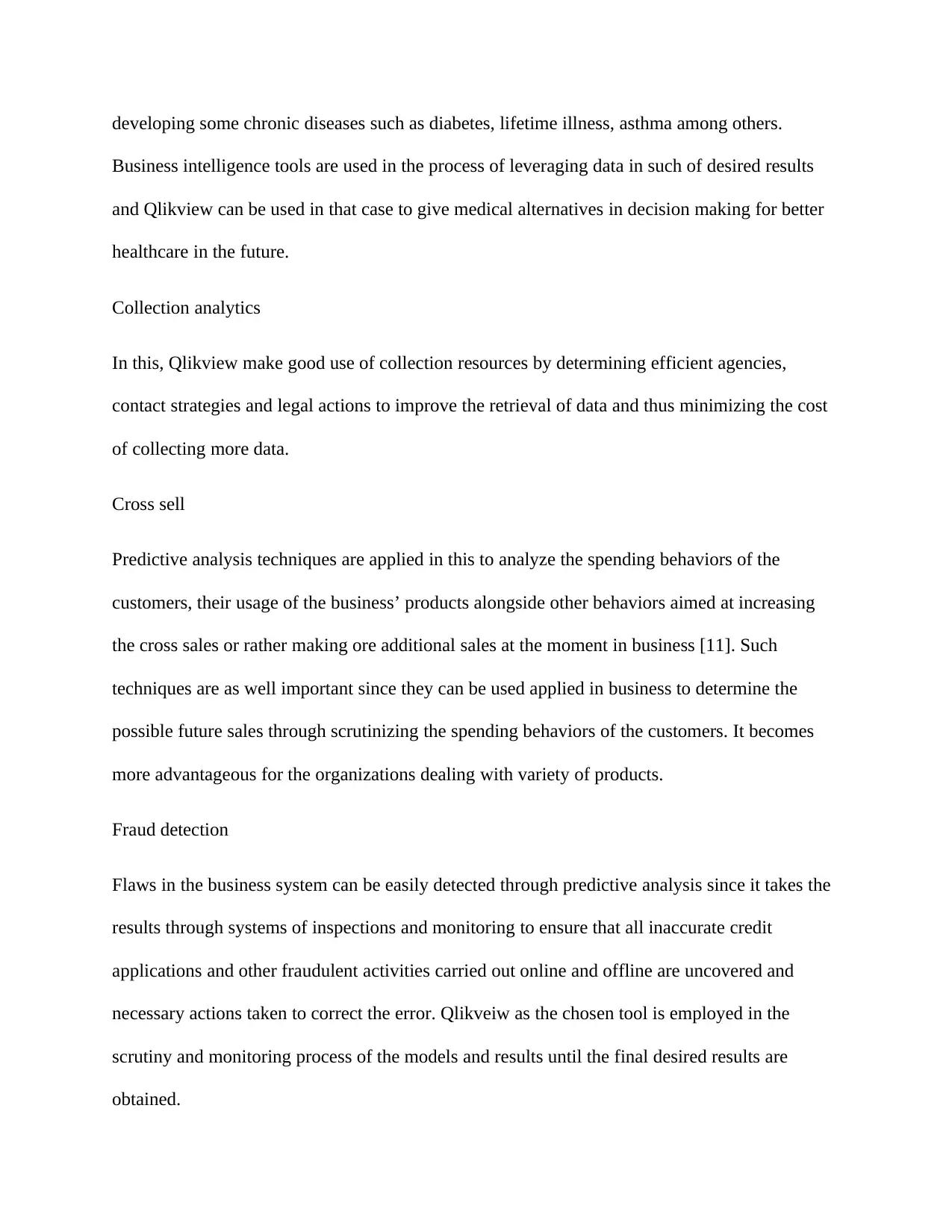
developing some chronic diseases such as diabetes, lifetime illness, asthma among others.
Business intelligence tools are used in the process of leveraging data in such of desired results
and Qlikview can be used in that case to give medical alternatives in decision making for better
healthcare in the future.
Collection analytics
In this, Qlikview make good use of collection resources by determining efficient agencies,
contact strategies and legal actions to improve the retrieval of data and thus minimizing the cost
of collecting more data.
Cross sell
Predictive analysis techniques are applied in this to analyze the spending behaviors of the
customers, their usage of the business’ products alongside other behaviors aimed at increasing
the cross sales or rather making ore additional sales at the moment in business [11]. Such
techniques are as well important since they can be used applied in business to determine the
possible future sales through scrutinizing the spending behaviors of the customers. It becomes
more advantageous for the organizations dealing with variety of products.
Fraud detection
Flaws in the business system can be easily detected through predictive analysis since it takes the
results through systems of inspections and monitoring to ensure that all inaccurate credit
applications and other fraudulent activities carried out online and offline are uncovered and
necessary actions taken to correct the error. Qlikveiw as the chosen tool is employed in the
scrutiny and monitoring process of the models and results until the final desired results are
obtained.
Business intelligence tools are used in the process of leveraging data in such of desired results
and Qlikview can be used in that case to give medical alternatives in decision making for better
healthcare in the future.
Collection analytics
In this, Qlikview make good use of collection resources by determining efficient agencies,
contact strategies and legal actions to improve the retrieval of data and thus minimizing the cost
of collecting more data.
Cross sell
Predictive analysis techniques are applied in this to analyze the spending behaviors of the
customers, their usage of the business’ products alongside other behaviors aimed at increasing
the cross sales or rather making ore additional sales at the moment in business [11]. Such
techniques are as well important since they can be used applied in business to determine the
possible future sales through scrutinizing the spending behaviors of the customers. It becomes
more advantageous for the organizations dealing with variety of products.
Fraud detection
Flaws in the business system can be easily detected through predictive analysis since it takes the
results through systems of inspections and monitoring to ensure that all inaccurate credit
applications and other fraudulent activities carried out online and offline are uncovered and
necessary actions taken to correct the error. Qlikveiw as the chosen tool is employed in the
scrutiny and monitoring process of the models and results until the final desired results are
obtained.
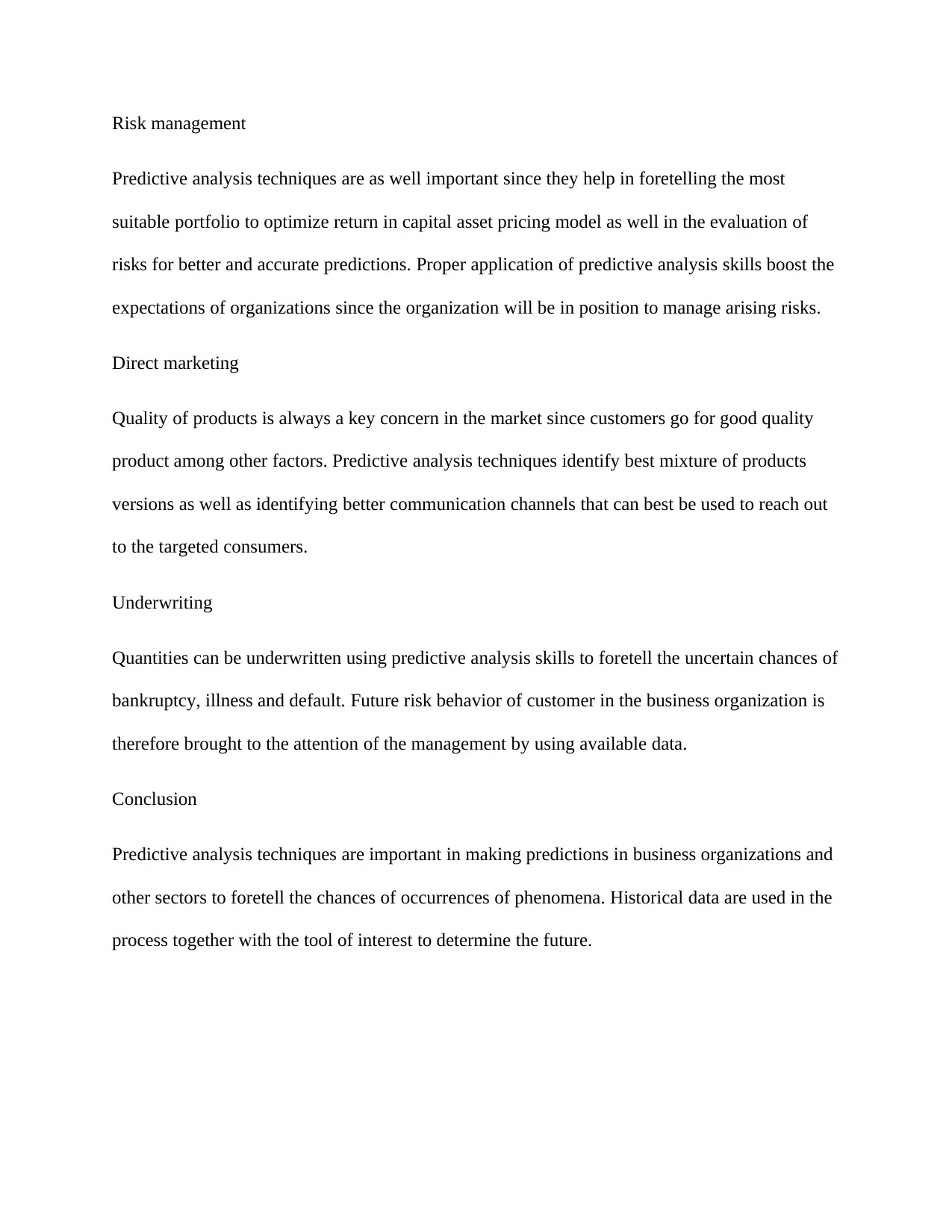
Risk management
Predictive analysis techniques are as well important since they help in foretelling the most
suitable portfolio to optimize return in capital asset pricing model as well in the evaluation of
risks for better and accurate predictions. Proper application of predictive analysis skills boost the
expectations of organizations since the organization will be in position to manage arising risks.
Direct marketing
Quality of products is always a key concern in the market since customers go for good quality
product among other factors. Predictive analysis techniques identify best mixture of products
versions as well as identifying better communication channels that can best be used to reach out
to the targeted consumers.
Underwriting
Quantities can be underwritten using predictive analysis skills to foretell the uncertain chances of
bankruptcy, illness and default. Future risk behavior of customer in the business organization is
therefore brought to the attention of the management by using available data.
Conclusion
Predictive analysis techniques are important in making predictions in business organizations and
other sectors to foretell the chances of occurrences of phenomena. Historical data are used in the
process together with the tool of interest to determine the future.
Predictive analysis techniques are as well important since they help in foretelling the most
suitable portfolio to optimize return in capital asset pricing model as well in the evaluation of
risks for better and accurate predictions. Proper application of predictive analysis skills boost the
expectations of organizations since the organization will be in position to manage arising risks.
Direct marketing
Quality of products is always a key concern in the market since customers go for good quality
product among other factors. Predictive analysis techniques identify best mixture of products
versions as well as identifying better communication channels that can best be used to reach out
to the targeted consumers.
Underwriting
Quantities can be underwritten using predictive analysis skills to foretell the uncertain chances of
bankruptcy, illness and default. Future risk behavior of customer in the business organization is
therefore brought to the attention of the management by using available data.
Conclusion
Predictive analysis techniques are important in making predictions in business organizations and
other sectors to foretell the chances of occurrences of phenomena. Historical data are used in the
process together with the tool of interest to determine the future.
Paraphrase This Document
Need a fresh take? Get an instant paraphrase of this document with our AI Paraphraser
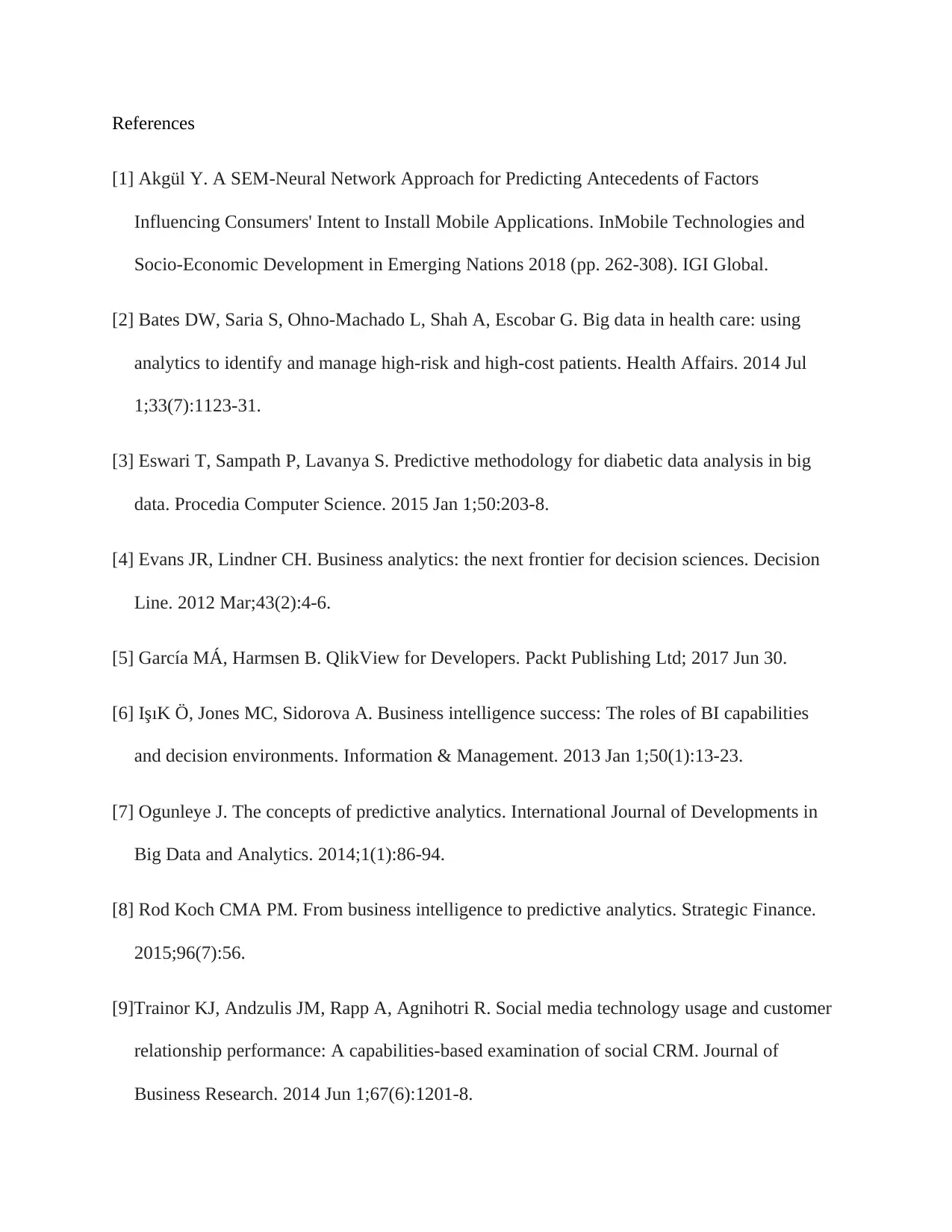
References
[1] Akgül Y. A SEM-Neural Network Approach for Predicting Antecedents of Factors
Influencing Consumers' Intent to Install Mobile Applications. InMobile Technologies and
Socio-Economic Development in Emerging Nations 2018 (pp. 262-308). IGI Global.
[2] Bates DW, Saria S, Ohno-Machado L, Shah A, Escobar G. Big data in health care: using
analytics to identify and manage high-risk and high-cost patients. Health Affairs. 2014 Jul
1;33(7):1123-31.
[3] Eswari T, Sampath P, Lavanya S. Predictive methodology for diabetic data analysis in big
data. Procedia Computer Science. 2015 Jan 1;50:203-8.
[4] Evans JR, Lindner CH. Business analytics: the next frontier for decision sciences. Decision
Line. 2012 Mar;43(2):4-6.
[5] García MÁ, Harmsen B. QlikView for Developers. Packt Publishing Ltd; 2017 Jun 30.
[6] IşıK Ö, Jones MC, Sidorova A. Business intelligence success: The roles of BI capabilities
and decision environments. Information & Management. 2013 Jan 1;50(1):13-23.
[7] Ogunleye J. The concepts of predictive analytics. International Journal of Developments in
Big Data and Analytics. 2014;1(1):86-94.
[8] Rod Koch CMA PM. From business intelligence to predictive analytics. Strategic Finance.
2015;96(7):56.
[9]Trainor KJ, Andzulis JM, Rapp A, Agnihotri R. Social media technology usage and customer
relationship performance: A capabilities-based examination of social CRM. Journal of
Business Research. 2014 Jun 1;67(6):1201-8.
[1] Akgül Y. A SEM-Neural Network Approach for Predicting Antecedents of Factors
Influencing Consumers' Intent to Install Mobile Applications. InMobile Technologies and
Socio-Economic Development in Emerging Nations 2018 (pp. 262-308). IGI Global.
[2] Bates DW, Saria S, Ohno-Machado L, Shah A, Escobar G. Big data in health care: using
analytics to identify and manage high-risk and high-cost patients. Health Affairs. 2014 Jul
1;33(7):1123-31.
[3] Eswari T, Sampath P, Lavanya S. Predictive methodology for diabetic data analysis in big
data. Procedia Computer Science. 2015 Jan 1;50:203-8.
[4] Evans JR, Lindner CH. Business analytics: the next frontier for decision sciences. Decision
Line. 2012 Mar;43(2):4-6.
[5] García MÁ, Harmsen B. QlikView for Developers. Packt Publishing Ltd; 2017 Jun 30.
[6] IşıK Ö, Jones MC, Sidorova A. Business intelligence success: The roles of BI capabilities
and decision environments. Information & Management. 2013 Jan 1;50(1):13-23.
[7] Ogunleye J. The concepts of predictive analytics. International Journal of Developments in
Big Data and Analytics. 2014;1(1):86-94.
[8] Rod Koch CMA PM. From business intelligence to predictive analytics. Strategic Finance.
2015;96(7):56.
[9]Trainor KJ, Andzulis JM, Rapp A, Agnihotri R. Social media technology usage and customer
relationship performance: A capabilities-based examination of social CRM. Journal of
Business Research. 2014 Jun 1;67(6):1201-8.

[10] Van Poucke S, Zhang Z, Schmitz M, Vukicevic M, Vander Laenen M, Celi LA, De Deyne
C. Scalable predictive analysis in critically ill patients using a visual open data analysis
platform. PloS one. 2016 Jan 5;11(1):e0145791.
[11] Waterhouse RM, Seppey M, Simão FA, Manni M, Ioannidis P, Klioutchnikov G,
Kriventseva EV, Zdobnov EM. BUSCO applications from quality assessments to gene
prediction and phylogenomics. Molecular biology and evolution. 2017 Dec 6;35(3):543-8.
[12] Zheng A. Finance Net-Interest Margin Analysis with Qlikview. InBusiness Analytics:
Progress on Applications in Asia Pacific 2017 (pp. 432-453).
C. Scalable predictive analysis in critically ill patients using a visual open data analysis
platform. PloS one. 2016 Jan 5;11(1):e0145791.
[11] Waterhouse RM, Seppey M, Simão FA, Manni M, Ioannidis P, Klioutchnikov G,
Kriventseva EV, Zdobnov EM. BUSCO applications from quality assessments to gene
prediction and phylogenomics. Molecular biology and evolution. 2017 Dec 6;35(3):543-8.
[12] Zheng A. Finance Net-Interest Margin Analysis with Qlikview. InBusiness Analytics:
Progress on Applications in Asia Pacific 2017 (pp. 432-453).
1 out of 9
Related Documents
Your All-in-One AI-Powered Toolkit for Academic Success.
+13062052269
info@desklib.com
Available 24*7 on WhatsApp / Email
![[object Object]](/_next/static/media/star-bottom.7253800d.svg)
Unlock your academic potential
© 2024 | Zucol Services PVT LTD | All rights reserved.





